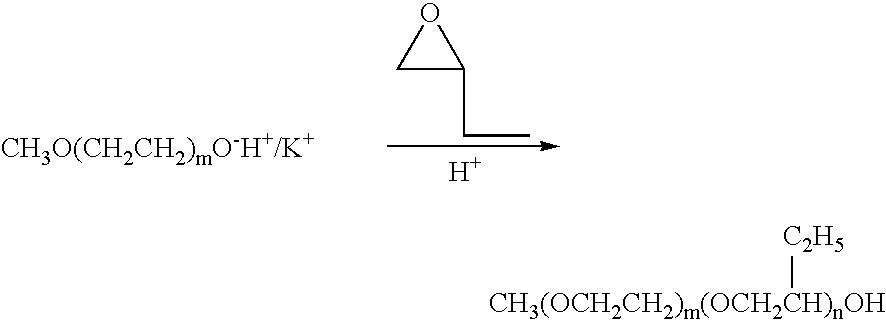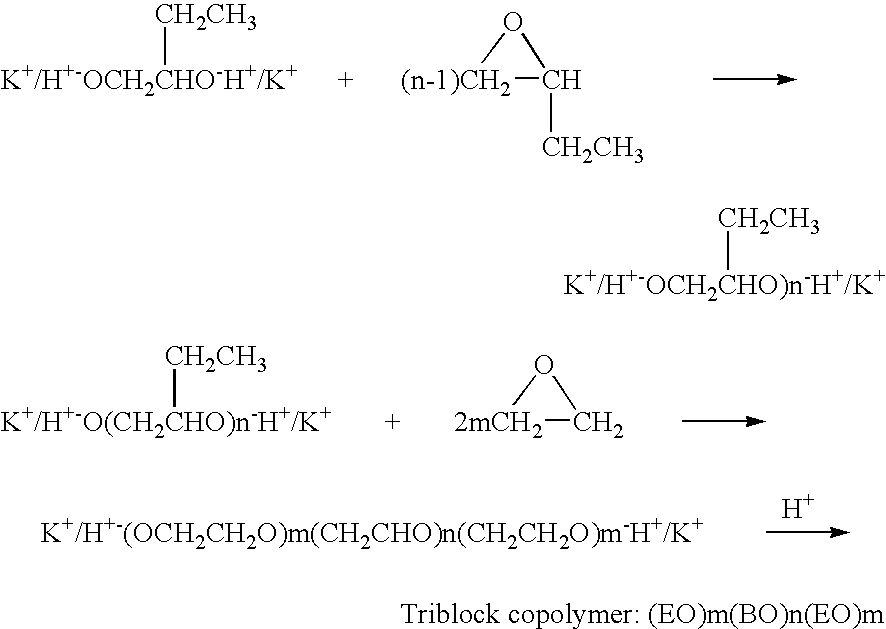Use of PEO-PBO block copolymers in ophthalmic compositions
a technology of ophthalmology and copolymer, applied in the field of ophthalmology, can solve the problems of high contact angle, affecting the cleaning effect of lenses, so as to facilitate the cleaning of devices and enhance the wettability of devices
- Summary
- Abstract
- Description
- Claims
- Application Information
AI Technical Summary
Benefits of technology
Problems solved by technology
Method used
Image
Examples
example 1
Contact Angle Measurements for Control Lenses: No Pre-Soaking
[0073]The contact angles for pHEMA-MAA lenses (Acuvue2®) and silicone hydrogel lenses (Acuvue Advance®, O2 Optix® and Pure Vision®), none having been exposed to a pre-soak treatment in a surfactant solution, were measured as described in this Example 1. The contact angle results are reported in Table 1 below, will hereinafter be referred to as the “Control Lens Results.”
[0074]Four different brands of contact lenses (one pHEMA-MAA lens type: Acuvue 2®; and three silicon hydrogel lens types: Acuvue Advance®, O2Optix® and Pure Vision®) were soaked in Unisol® saline solution overnight to remove residual packing solution contaminants, prior to measuring the contact angles. The contact angle of each lens was then measured according to the Sessile drop method, as described below, at room temperature, i.e, 23° C.±0.5. The results are presented in Table 1, below.
Sessile Drop Method
[0075]A video based contact angle measuring system ...
example 2
Amount of Tetronic® 1304 and (EO)45—(BO)14 Uptake by pHEMA-MAA (Acuvue2®) and Silicone Hydrogel (Acuvue Advance®) Lenses after a Pre-Soak in Surfactant Solutions A, B and C
[0077]All contact lenses were soaked in Unisol® saline solution overnight to remove residual packing solution contaminants. Surfactant solutions A, B and C were prepared by dissolving each of the formulation components, as shown in Table 2 below, in water. Into a clean glass vial, one lens of each type (i.e., one Acuvue 2® one Acuvue Advance®) was taken directly from the pack and pre-soaked in 10 ml of each surfactant solution for 24 hours. The lenses were then removed from the solutions and blotted dry. The lenses were then rinsed by immersion in Unisol® saline solution (10 mL), removed from the vials, patted dry and stored in a glass vial. The uptake concentration was then measured using the dye method as reported in Ketelson et al., Colloids and Surfaces Biointerfaces, vol. 40, pages 1-9 (2005). The uptake conc...
example 3
Contact Angle Measurements for Acuvue 2® (pHEMA-MAA) and Various Silicone Hydrogel Lenses after a Pre-Soak in 0.1% (EO)45—(BO)14 Solution (in Unisol®)
[0079]All contact lenses were soaked in Unisol® saline solution overnight to remove residual packing solution contaminants. The lenses were then pre-soaked for 24 hours in a 0.1% (EO)45—(BO)14 solution (in Unisol®). The contact angle of each lens was then measured according to the Sessile drop method, as described above in Example 1, at room temperature, i.e, 23° C.±0.5.
TABLE 3Contact Angle Measurement for Various Lens Types(°)CycleAcuvueNumberAcuvue 2 ®Advance ®O2Optix ®Pure Vision ®00000100002000030034041204005500440640045073304608750390
[0080]The above data demonstrate that the contact angle for all lens types decreases relative to the control lenses (see Example 1 above). Pre-soaking the lenses in a 0.1% (EO)45—(BO)14 solution in Unisol® saline reduced the contact angles, indicating that the surfaces of all lens types were more wett...
PUM
| Property | Measurement | Unit |
|---|---|---|
| Fraction | aaaaa | aaaaa |
| Fraction | aaaaa | aaaaa |
| Mass | aaaaa | aaaaa |
Abstract
Description
Claims
Application Information
 Login to View More
Login to View More - R&D
- Intellectual Property
- Life Sciences
- Materials
- Tech Scout
- Unparalleled Data Quality
- Higher Quality Content
- 60% Fewer Hallucinations
Browse by: Latest US Patents, China's latest patents, Technical Efficacy Thesaurus, Application Domain, Technology Topic, Popular Technical Reports.
© 2025 PatSnap. All rights reserved.Legal|Privacy policy|Modern Slavery Act Transparency Statement|Sitemap|About US| Contact US: help@patsnap.com



